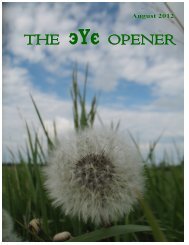Spring 2010 Edition #2 - Saskatchewan College of Opticians
Spring 2010 Edition #2 - Saskatchewan College of Opticians
Spring 2010 Edition #2 - Saskatchewan College of Opticians
Create successful ePaper yourself
Turn your PDF publications into a flip-book with our unique Google optimized e-Paper software.
DOCTORS IMPLANT TOOTH IN BLIND WOMAN’S EYE<br />
Lending a whole new meaning to the term "eyetooth," Miami surgeons have implanted a tooth in a 60-year-old blind woman's<br />
eye, using it to anchor an artificial cornea that has restored her vision, lost for nine years. "I'm looking forward to seeing my seven<br />
youngest grandchildren for the first time," said Sharon "Kay" Thornton, who was blinded by Stevens-Johnson syndrome in 2000.<br />
The rare, serious skin condition destroys cells on the surface <strong>of</strong> the eye, causing severe scarring <strong>of</strong> the cornea that prevents a cornea<br />
transplant or use <strong>of</strong> a conventional artificial cornea. After an attempt to correct her problem using gene therapy failed, Dr. Victor L.<br />
Perez <strong>of</strong> the Bascom Palmer Eye Institute at the University <strong>of</strong> Miami's Miller School <strong>of</strong> Medicine decided to try an unusual<br />
procedure called modified osteo-odento-keratoprosthesis that had been developed in Italy but never tried in the United States.<br />
Earlier this summer, Dr. Yoh Sawatari, an oral surgeon at the Miller School, removed one <strong>of</strong> Thornton's canine or "eye" teeth<br />
the pointed teeth in the upper jaw, so-named because they sit directly beneath the eyes--and the bone surrounding it. Technicians<br />
shaved the tooth and bone and sculpted it to the proper shape, then drilled a hole through it to insert a cylindrical optical lens. The<br />
combined tooth and lens were then implanted in Thornton's shoulder to allow them time to become fully integrated.<br />
Meanwhile, Perez prepared the surface <strong>of</strong> the eye by removing the scar tissue surrounding the damaged cornea. About a month<br />
later, moist skin from inside her cheek was used to cover and rehabilitate the surface <strong>of</strong> the eye. Two months later, around the<br />
beginning <strong>of</strong> September, Perez removed the tooth from her shoulder and implanted it in Thornton's eye, carefully aligning it with the<br />
center <strong>of</strong> the retina. A whole was made in the mucosal material from the cheek to allow the lens to protrude through and collect light.<br />
When the bandages were removed from Thornton's eye on Labor Day weekend, she was able to recognize faces within hours.<br />
Now, two weeks later, she is reading newsprint with a visual acuity <strong>of</strong> 20/70. Doctors expect her vision to continue to improve as the<br />
surgical scars heal.<br />
The procedure was originally developed in 1963 by Italian ophthalmologist Dr. Benedetto Strampelli. It was not very successful<br />
initially, however, because <strong>of</strong> serious complications--such as the tooth falling out <strong>of</strong> the eye. Modifications by Dr. G. Falcinelli <strong>of</strong><br />
Italy solved those problems, however, and the procedure is now used in Europe and Japan--albeit rarely. Perez traveled to Rome to<br />
learn the technique from Dr. Falcinelli.<br />
C/P (Sept 2009)




